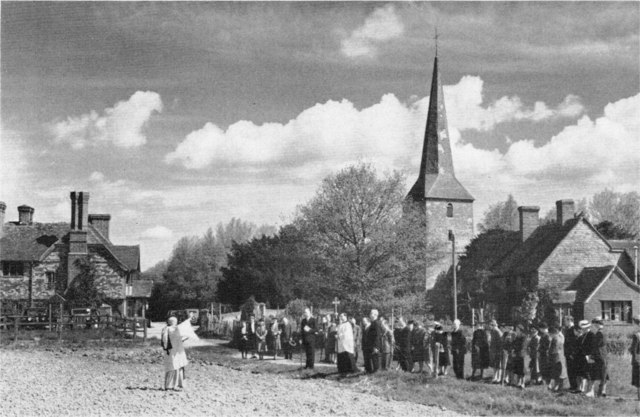This upcoming Sunday is Rogation Sunday, followed by the Rogation Days on Monday, Tuesday, and Wednesday. The lore of these days includes “beating of the boys” and a mysterious pastry called “Rammalation Biscuits,” so research was particularly interesting.
What are the Rogation Days and how did they begin?
From the always helpful Anglican resource Full Homely Divinity:
The Rogation Days, the Monday, Tuesday, and Wednesday before Ascension Day, originated in Vienne, France (not Vienna, Austria), in 470 after a series of natural disasters had caused much suffering among the people. Archbishop Mamertus proclaimed a fast and ordered that special litanies and prayers be said as the population processed around their fields, asking God’s protection and blessing on the crops that were just beginning to sprout. The Latin word rogare means “to ask”, thus these were “rogation” processions. In an agricultural society, closely connected with the soil and highly vulnerable to the uncertainties of nature, this was an idea that took root quickly, and the custom spread around Europe and over to Britain. The Sunday before the Rogation Days came to be considered a part of Rogationtide (or “Rogantide”) and was known as Rogation Sunday. The Gospel formerly appointed for that day was from John 16, where Jesus tells his disciples to ask, and ye shall receive.
Gradually, the Rogation Days became a time of festival, celebrating the advent of spring
and other things. The members of a parish would process around the boundaries of the parish, which could take a whole day:
The route of the walk was around the boundaries of the parish, which was a civil as well as a religious unit. Thus, the processions were useful in teaching people, particularly the young, their parish boundaries. Known as “beating the bounds,” the processions customarily stopped at boundary marks and other significant landmarks of the parish, such as a venerable tree, or a great rock, or perhaps a pond. The priest would read the Gospel and perhaps affix a cross to the landmark. Then the boys of the parish would suffer some indignity intended to help them remember the spot. Boys were bumped about against rocks and trees, thrown intothe water, held upside-down over fences, thrown into bramble patches, or beaten with willow wands–and then given a treat in compensation. In later times, the marchers beat the boundary marker with the willow wands, beating the bounds, rather than the boys.
This became a time for boundary disputes between landowners to be resolved. And, in time, the day broadened beyond physical boundaries to also assessing relational trespasses within the parish and reconciling those boundaries as well.

Why is it good for us to still celebrate the Rogation Days in the modern world?
George Herbert gave the following reasons to observe the Rogation Days, that are still practical for us today: 1) a blessing of God for the fruits of the field; 2) Justice in the preservation of the bounds; 3) Charitie, in living, walking and neighbourliy accompanying one another, with reconciling of differences at that time, if they be any; 4) Mercie, in relieving the poor by a liberal distribution of largess which at that time is or oght be made.
I remember the first time I participated in our church’s Rogation Day “Beating of the Bounds.” I was deeply impressed by the way that the Rogation Days took seriously the life of the body in the world. Our church is located in an inner-city depressed neighborhood, so it looks a little odd to have a priest, acolytes, and parishioners processing around the neighborhood with the crucifix, praying for gardens and chanting psalms. But, somehow, despite feeling incongruous, participating in this tradition also felt holy and joyful.
Wendell Berry wrote the following that I think pertains to Rogation Days and why it is good for us and our children– even if we are urban or suburban– to internalize these days:
“No matter how urban our life, our bodies live by farming; we come from the earth and return to it, and so we live in agriculture as we live in flesh. While we live our bodies are moving particles of the earth, joined inextricably both to the soil and to the bodies of other living creatures. It is hardly surprising, then, that there should be some profound resemblances between our treatment of our bodies and our treatment of the earth. . . .
At some point we began to assume that the life of the body would be the business of grocers and medical doctors, who need take no interest in the spirit, whereas the life of the spirit would be the business of churches, which would have at best only a negative interest in the body. . .
And yet what is the burden of the Bible if not a sense of the mutuality of influence, rising out of an essential unity, among soul and body and community and world? These are all the works of God, and it is therefore the work of virtue to make or restore harmony among them. The world is certainly thought of as a place of spiritual trial, but it is also the confluence of soul and body, word and flesh, where thoughts must become deeds, where goodness is to be enacted. [1]
What are some customs to incorporate in observing the Rogation Days?
Besides the “Beating of the Bounds,” supplication, and reconciliation, it is customary to also celebrate with food and drink. “Ganging beer” was an ale specially brewed for the Rogation Days. This didn’t have a special recipe– it was just beer brewed for the day, so any good beer that feels “rogation-y” will work.
The Rogation Days also lay claim to a culinary mystery: an intriguing pastry known only as “Rammalation Biscuits.” No one seems to have any idea what these were, though the word “rammalation” most likely derives from “perambulation.” So, perhaps you can make biscuits for your family that seem suitable for “rammalation.” Keep in mind, as well, that the British use the word “biscuits” to refer to cookies, so the boundaries for this particular pastry are wide indeed.
Lastly, Bley has designed a beautiful prayer flag printable for you to print for your family’s house or garden.
[1] Wendell Berry, “The Body and the Earth,” in The Unsettling of America: Culture and Agriculture (San Francisco: Sierra Club Books, 1977) p. 97.


Thank you for this informative and thought provoking article.
LikeLiked by 1 person
Pingback: It’s Almost Rogation Sunday… | The Homely Hours
This is a great post. The Rogation procession had been explained to me (by an Epis priest) as a leftover pagan practice. Thank you for clearing that up!
LikeLike
Pingback: Rogation Days? – All Saints Anglican Church
Pingback: Rogation Days: A Rookie Anglican Guide - Anglican Compass
Pingback: Rogationtide at home – The Saint Aelfric Customary